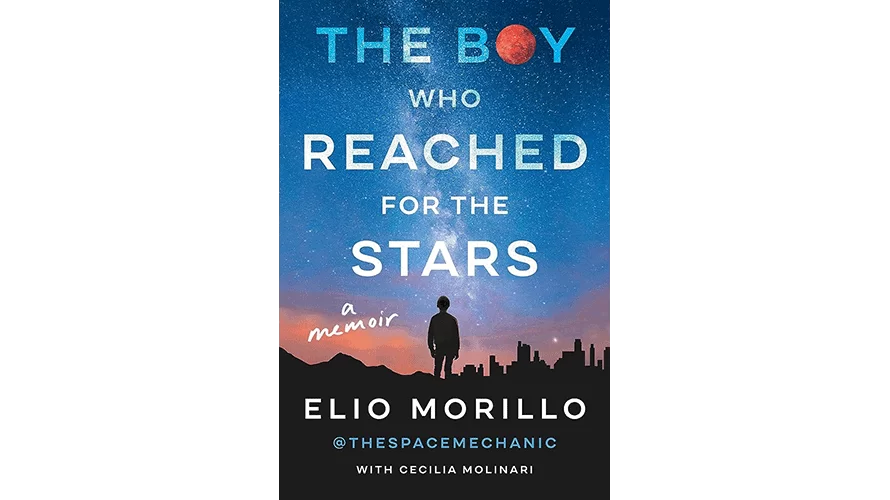Category: Nonfiction
Reviewed by: Peter Spasov
Title: The Boy Who Reached for the Stars: A Memoir
Author: Elio Morillo with Cecilia Molinari
Format: Hardcover, Kindle
Pages: 208
Publisher: HarperOne
Date: June 2023
Retail Price: $28.99/$12.99
ISBN: 978-0063214316
Find this book
From poverty to the surface of Mars demands a journey of perseverance. But love too is a prerequisite, the love for exploration, for science and family. Even when starting from humble beginnings, one can aspire to building robotic vehicles for exploring our cosmic neighbor. Elio Morillo has lived what many of us would dream to do. At the beginning he was a child thrown into poverty, yet has worked on the Mars Perseverance rover and its Ingenuity helicopter. His memoir offers the reader an intimate glimpse into both the good and ugly of living for space.
Throughout the memoir, the author makes occasional socio-economic commentaries, including racism and discrimination. Elio muses upon how children can break racial barriers for adults. Also, he addresses status and social class. Fortunately, through persistence and some luck, he usually found like-minded companions and dedicated teachers. He credits outreach programs for assisting the disadvantaged. In one case, he segues into a passage about DART for asteroid defense. Later, he critiques SAT, the standardized test for college admission, for being about memorization instead of problem solving. “Yet another automated system that needs to be humanized,” Elio writes.
He describes engineering styles, contrasting free-thinking to methodical. Art acts as inspiration, according to the author. He reports upon the space-age events such as 2003 Mars Exploration Rovers and the Challenger disaster which happened throughout his Puerto-Rico period. Elio found inspiration by following the experiences of the few Hispanic astronauts and space engineers at that time. On occasion, his phrasing will sport an astronautical flavor, such as “threw him off his orbit.” The titles of his fifteen chapters mirror the phases of a space mission; for instance, chapter four is Ground Support: My Chosen Family.
Born in Ecuador, Elio was a boy who already took toys apart in order to figure out how they worked. His Mami raised him as a single mother for most of his life. Due to economic difficulties, Mami and Elio eventually moved to New York City. Beginning with learning English, Elio always applied himself to acquiring new skills. In his words, “I’ve never been one to half-ass anything in my education,” a theme persisting throughout his life. He was also a Power Rangers fan. Again, circumstances forced another move and Mami and Elio moved to Puerto Rico where Mami further influenced him by upgrading herself and becoming a teacher.
When economic difficulties again uprooted Elio and his Mami, they returned to New York City where he struggled to gain acceptance into, in his words, a decent STEM school. Having had an academic record of straight A’s, a guidance counselor finagled to drop some to B’s, because, according to the counselor, no school will believe Elio’s all A’s. Here Elio offers an eye-opener about the extremity of school differences in the United States. The importance of attending the ‘right’ school is paramount. This choice strongly influences whether one ends up contributing to society or ends up in a class of dysfunctional classmates acting as gangsters. He perseveres and discovers he is a natural in physics, which appealed to his mechanics-loving mind.
Alas, the faked B’s in his academic record impeded applying to the university programs he desperately desired. His indignant Mami fought the school system to eventually restore his record to the straight A’s they always were. Eventually opportunity arose, and Elio had the drive to take advantage of it. He won acceptance into collaboration between his high school and the NYU Astrophysics Department, during which he impressed attendees at the American Astronautical Conference. Later he thrived at a summer STEM camp, gaining exposure to CAD, design for manufacturability and design process. His robotics team won first prize in a competition. Eventually, with financial aid, Elio enrolled at the University of Michigan. Projects included designing a blimp to work on Mars.
As Elio emphasizes, mentorship and family supports are key in one’s engineering education. He describes the College Survivor versus College Thriver cycle faced by disadvantage youth. During his university years he coached other disadvantaged youth to overcome barriers, particularly when one’s parents struggle in menial work with long hours and little money. In his philosophical musings, he promotes networking via professional associations and conferences. But then he too struggled with losses, such as the passing away of loved ones.
Elio advocates practical internships rather than an onslaught of theory-based courses. In his case, his internships included SpaceX, Boeing and eventually JPL, where he developed a mini rover, while taking care of his elderly Mami on the pay of a graduate student. There too was the struggle with empathy skills while teaching undergrads. Eventually he became a systems testbed engineer for the Mars 2020 mission. The author highlights testing, troubleshooting and the tools needed for operating the rover from Earth, including role playing games. When COVID hit, the pressures and stresses hit as Elio’s workload increased, pushing him to a breaking point. He is open about this experience, including months of therapy and his efforts to ‘climb out of a black hole’ during ‘Operation Joy.’ Eventually he left JPL and joined Blue Origin in its quest to build a lunar colony.
The author writes from the heart, about education and the breaking of the generational poverty cycle. This book will interest readers for showing the human story of becoming a space-technology engineer, and, in particular, will inspire youth to pursue their own aerospace dreams.
© 2023 Peter Spasov



















